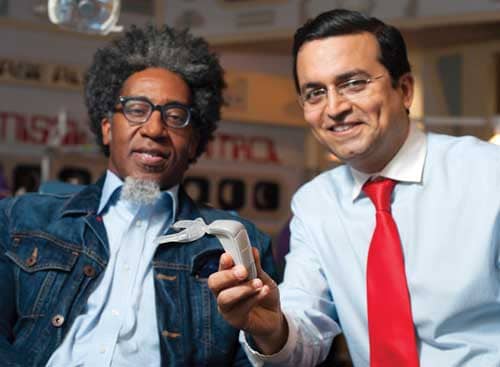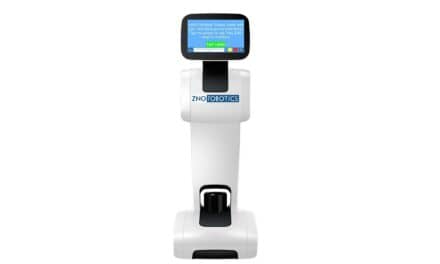
Cedric (left), a 53-year-old patient, said “no” to surgery and 2 years in braces to correct his malocclusion. Bhagia instead recommended AcceleDent as part of Cedric’s treatment plan. Photo by Alysha Beck.
Orthodontics is in a golden age—technology advancements are everywhere. As a result, patients have expectations about their care. It has been my experience that patients want to be treated by an orthodontist who can offer them the latest technological advantages—and this includes advancements in accelerated orthodontic treatment.
At this point, I believe accelerated orthodontics, and the technology associated with it, is here to stay. I, like many of my colleagues, am excited by this treatment development because I love technology and continually strive to maximize the orthodontic experience for my patients. But after the initial excitement of potentially delivering improved patient care wears off, I, like many of you, must look at the clinical evidence surrounding a product and tackle the business implications of integrating such new technologies into my practice.
When I made the decision to incorporate OrthoAccel Technologies’ AcceleDent®, the FDA-cleared Class II medical device that speeds up orthodontic treatment by as much as 50%, I had to weigh what the device would really mean for my practice.
From a clinical standpoint, I know it works. My patients are getting through treatment faster and they’re happy about it. That said, the business implications of integrating something like this have to be considered—and it’s these business questions, specifically price, patient acceptance, practice integration, and overall return on investment, that often dominate my discussions with other orthodontists about incorporating AcceleDent.
The fact is, I shared the general skepticism about how this device could improve my practice when I first introduced it. But as I used it more, I saw how it not only made good sense clinically, but good sense financially for my practice.

OrthoAccel Technologies’ AcceleDent is an FDA-cleared Class II medical device that speeds up orthodontic treatment by as much as 50%, according to the company. Photo by Alysha Beck.
Answering the Price Question
When I talk to orthodontists about AcceleDent, the first question after understanding the clinical benefits of the device is often about price. For me, my compensation is based on providing patients high quality orthodontic care rather than profiting from selling the device itself. Accelerated orthodontics is now a part of that promise of “high quality orthodontic care” at my practice, Space Center Orthodontics in Clear Lake, Tex.
What has worked for my practice, and what I believe will work for most practices, is pricing AcceleDent to cover the cost of offering the device. A traditional orthodontic case at my practice costs about $5,000. An accelerated case with AcceleDent at my practice costs about 10% to 15% more. That model has worked for me; I don’t lose money on my accelerated cases and I make significant gains in patient satisfaction. I’m able to keep my costs low by purchasing my AcceleDent units in volume through the company’s AcceleDent Advantage Membership Rewards (AAMR) program.
The pitfall to avoid is to evaluate the cost and viability of AcceleDent based on the cost of purchasing a couple of units during a trial phase. Yes, by all means, you should purchase a couple of units to try it out and see how well you can incorporate it into your clinical cases before purchasing a large quantity. However, don’t develop your business plan for AcceleDent based on the purchase price of one or two units. You’re going to offer the best value to your patients and keep your overhead costs low by purchasing it through the AAMR program. Base your costs off that price, not the ad hoc per unit cost.
Will Patients Pay for It?
Purchasing in quantity takes orthodontists to their next stage of hesitation, “Will patients really pay more for accelerated treatment?” Yes, my experience is that they will pay 10% to 15% more. Still hesitant, the next question is likely to be “What comes first: the chicken or the egg?” My response to that is yet another pop culture cliché, “If you build it, they will come.”
We know anecdotally that two of the primary clinical barriers to orthodontic treatment are patients’ concerns with treatment duration and pain. We have clinical proof that AcceleDent accelerates treatment and I repeatedly hear from patients how it alleviates discomfort. It’s important to note that it’s not just wealthy patients who are willing to pay for accelerated treatment with AcceleDent. The value of faster, more comfortable treatment has far-reaching appeal, so I suggest that you not make assumptions about patients’ motivations.
As background, my practice is located in a suburban area, 24 miles from Houston. My patients are a mix of white and blue collar workers. I would describe it as predominately middle class and ethnically diverse.

A 26-year-old female patient wanted to complete treatment in 8 months, ahead of her upcoming wedding (left). Projected treatment time was 15 months. Patient opted to include AcceleDent as part of her treatment. With AcceleDent, patient completed treatment in 8 months (right).
My team talks to nearly every patient about AcceleDent and, based on the 100 or so AcceleDent patients that I currently have, I’ve concluded that there are factors beyond demographics that influence whether someone is an ideal candidate for accelerated treatment.
1) Patients who have a deadline. Recently, a patient visited our office and said she had to complete her orthodontic treatment prior to her wedding, which was in 8 months. She was one of my first trial phase AcceleDent patients. I told her about AcceleDent and, because of her deadline, she was interested and willing to pay extra for faster treatment. With AcceleDent, her treatment lasted exactly 8 months and she was delighted with the results.
2) Professionals in the public eye. Performers, models, lawyers, and athletes are good examples. They want to complete treatment as quickly as possible because their appearance is a high priority.
3) Difficult orthodontic cases. There are some orthodontic cases that I prefer to treat only in conjunction with AcceleDent. It makes things easier on the clinical side and helps patients stay invested throughout treatment. These are cases where there are impacted teeth or borderline surgery cases. Standard orthodontics would make these slow and difficult cases, but when patients understand that their difficult case can be accelerated, suddenly they’re not dreading treatment as they were previously. One of my patients, Cedric, is an example of this type of case. During my initial consult with Cedric, I presented surgery as an option to correct his malocclusion. Cedric, who is 53 years old, said “no” to surgery and “no” to 2 years of braces. I told him about AcceleDent and he said “yes” to accelerated treatment. He continues to be pleased with his progress and his decision.
These are by no means the only examples. I’ve found that you won’t know whether your patient will want to make the investment in accelerated treatment unless you ask. My advice is that you present the option to all your patients—new and existing.
In my practice, we’ve placed an emphasis on increasing awareness in the community by marketing the benefits of our accelerated treatment options. AcceleDent display units and brochures are prominently placed throughout the office. We feature AcceleDent on our website and post about it on social media. Our team talks about it during the initial patient consult and throughout treatment.
To move your AcceleDent inventory quickly, price it reasonably, explain to patients the clinical advantages of faster orthodontic treatment, and incorporate the marketing materials throughout the practice and online. On average, we currently prescribe seven to 10 AcceleDent units per month to patients.
Practice Integration
Integrating AcceleDent was a fairly seamless transition for my practice. There has been no change in staffing, office hours, or operations costs. The only change that impacts the front office is a slight difference in scheduling for our accelerated treatment patients. Our braces patients are either seen more often or sometimes able to skip a wire in the usual wire sequence since their teeth are moving faster. We see our aligner patients at the same schedule, but we give them double the amount of aligners at every visit, resulting in nearly 50% less total office visits.
It’s also important to point out that we’ve had no major issue with compliance. I believe it’s because faster orthodontic treatment and less discomfort are compelling incentives. I remind patients about AcceleDent’s Fast Track Usage Report and have shown some patients the usage, but ultimately I put the responsibility on them. I tell them if they use it, they’ll complete treatment faster. This is not a new conversation for orthodontists. We’ve been having compliance conversations with patients for years, reminding them to wear their rubber bands. I choose not to scold my patients, rather just remind them that their treatment will only go faster if they comply with AcceleDent’s 20-minute daily routine. Overall, patients have been steady with their compliance and receive even further encouragement to continue when they notice their own accelerated progress.
Quantifying Return on Investment
Finally, we come to the golden question. Orthodontists want to know and see tangible results from offering accelerated orthodontics. However, orthodontists don’t ask how much profit they’ll see on the cost of standard brackets or aligner trays, and it’s no different with accelerated treatment. For me, I quantify ROI in terms of the number of satisfied patients who have left my chair with healthy, beautiful smiles in half the time and with less pain. Aside from patient satisfaction, we can also quantify patient referrals and GP referrals. At least once or twice a week, an AcceleDent patient will come in singing the praises of their accelerated treatment and thanking us for offering it. These pleased patients undoubtedly share that same feedback with friends, family, and coworkers. I anticipate that this will yield an increase in direct patient referrals over time, but I am realistic that this will not happen overnight. As word spreads, there will be an increased consumer preference for practices that offer accelerated orthodontics.
It may be my love for technology, but I envision accelerated treatment becoming the standard of care for our industry. Instead of debating the ROI from accelerated treatment, we may soon begin discussing the opportunity cost of not offering it, especially with the introduction of more accelerated treatment options. Each orthodontist should assess which accelerated technology is best for improving their patient experience. Based on my experience, AcceleDent is the least invasive and the easiest accelerated treatment option to integrate into clinical practice.
Offering accelerated orthodontics should be mutually beneficial for patients and practices. We are all in business to be profitable while giving patients the smiles they deserve. However, I think it’s also our duty to offer patients the latest clinical advancements. This doesn’t have to mean that we eat the cost of offering new technology, but it also doesn’t mean that we have to put a premium price on a common sense and better way to provide orthodontic treatment. OP










